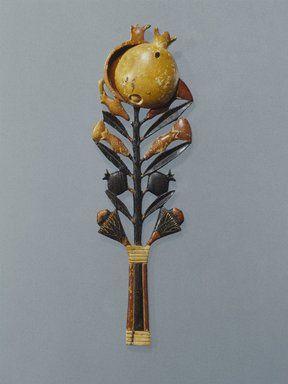
Medium: Ivory
Geograhical Locations:
Dates:ca. 1336–1327 B.C.E.
Dimensions: 2 9/16 x 11/16 x 8 3/16 in. (6.5 x 1.8 x 20.8 cm)
Collections:
Museum Location: 19th Dynasty to Roman Period, Martha A. and Robert S. Rubin Gallery, 3rd Floor
Exhibitions:
Accession Number: 42.411
Image: 42.411_SL1.jpg,
Catalogue Description: Polychromed ivory ointment-spoon in the shape of a pomegranate, with a stem bearing flowers and small pomegranates forming the handle. The pomegranate forming the bowl of the spoon is in two sections, the upper one serves as a cover. It opens on a swivel pin; part of a small knob (?) used for turning it still survives. The stem, bearing two pairs of flowers, three pairs of lanceolate leaves and a pair of small pomegranates, has, at the base two half-opened lotus flowers on long stems which are represented as being bound by withes to the pomegranate stem to form the manche of the handle. The large pomegranate forming bowl of the spoon is painted in a warm, pale brown, the flowers are deep red, the leaves, stem and small fruits black, the withes at the handle pale brown and the lotus stems red. Save that the underside of the large pomegranate is somewhat flattened to provide a surface on which to rest the spoon, the piece is identical on the two sides. Probably made for funerary purposes, not for actual use.